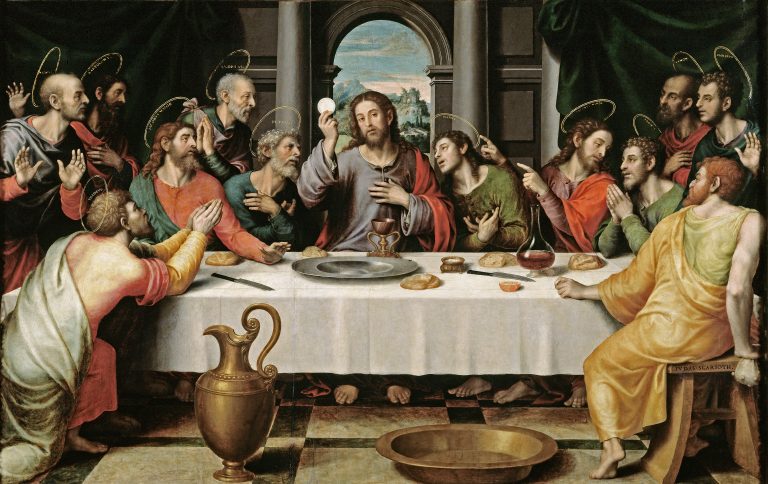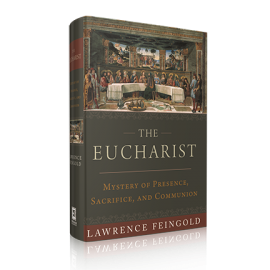By Kenneth J. Howell

When one picks up an academic book, one does not expect to find a lot of beauty. Rarely is an academic book worthy of such appellations as lofty or sublime. Lawrence Feingold’s The Eucharist: Mystery of Presence, Sacrifice, and Communion is the exception and can be aptly characterized as both an aesthetic and intellectual feast. It is not that beauty is found on every page or that the author sacrifices intellectual excellence at the expense of spiritual edification. It is rather that there are nuggets of beauty precisely at junctures where one least expects them. In reminding us of the centrality of the Incarnation, Feingold says, “His [Christ’s] self-emptying reveals the incomprehensible depth of the love and mercy that undertakes an infinite humiliation.” (13). In discussing the Real Presence, the author elaborates on the nature of charity implicit in both the Incarnation and the Eucharist, “Charity condescends to the level of the person loved so that the beloved feels no humiliation or intimidation.” (14).
Feingold makes the connection between the Incarnation and the Eucharist a centerpiece of his book. In this he follows St. Thomas who taught that all the sacraments, but especially the Eucharist, point back to and derive their power from the Paschal Mystery. St. Thomas Aquinas’s teaching on the Eucharist constitutes the center of gravity in this book. In one way or another the author repeatedly circles back to Thomas but as he rounds the circle he draws on the likes of St. Augustine in antiquity and Matthias Scheeben in modern times. The result is a Thomistic doctrine built on patristic foundations --- just as Thomas would have wanted --- and extended into modern times by Scheeben and his successors such as John Paul II and Benedict XVI. The latter’s multivariant theology leaves a definitive stamp on Feingold’s book.
This book has a tripartite structure based on the traditional scheme of Presence, Sacrifice, and Communion. This is significant because although the book boasts a hefty six hundred plus pages, Feingold shows no desire to be an innovator. His higher purpose is to explicate the Tradition of the Church with regard to the Eucharist and to show its intimate connections with other aspects of Catholic theology. In this regard, Feingold is not afraid to enter into biblical exegesis (chapters 1-3) in a manner that is sometimes lacking in systematic theologies. His attention to detail whets the appetite for more. An example is his treatment of the prefigurations of the Old Covenant (chapter 2) in which God was teaching the people of Israel the hidden meaning of the sacrifices he commanded. The Lord desired to instill hope for a greater deliverance to come.
It is in the systematic portion of the book (chapters 6-16) that Feingold especially excels in his exposition of the Thomistic doctrine of the Eucharist. I suspect this emphasis is not out of an overzealous devotion to the Angelic Doctor, but simply because he has found what so many others have found, namely, that St. Thomas addressed the Eucharist from so many angles that it is hard to raise a question that he did not consider. The author also relies on Thomas in another fundamental respect; he draws on Thomas’s theological method of argumentation from fittingness or convenientia, In a previous book on theological method (Faith Comes from what is Heard), Feingold explicated Thomas’s method of argument by analogy, not to prove supernatural mysteries but to show their coherence with other truths. Convenientia has everything to do with how the different components of revealed truth fit together into a holistic picture. Though Feingold does not say so here, it may be worth noting that the method of convenientia was in some ways an anticipation of modern scientific method. The formulation of natural laws (e.g. gravitation) is an attempt to bring a diversity of phenomena under the same predictive principle. Newton’s achievement in his famous F = MA united freefall, projectile, and planetary motion. In everyday language, science is about how natural things fit together. So too, theology is about how the different aspects of revealed truth fit together. Feingold shows this in multiple ways. He shows how the Eucharist fits the sacrificial system of the Old Covenant and how it not only fits but flows out of the Incarnation.
This means that the Eucharist is the greatest of the sacraments, or as Thomas put it, the sacramentum sacramentorum. Like the Incarnation, the sign character of the Eucharist means that it carries what it signifies. The earthly body of Christ was a sign carrying the Logos within it; the Eucharist is a visible manifestation that carries the reality (res) within the sign (sacramentum) itself. That reality is the Divine Presence and Nature so that the human race might enjoy the Beatific Vision as a result of deification. This all makes for an internal coherence or fittingness worthy of the blessed gift of the Eucharist and one of its greatest expositors, the Angelic Doctor.
The theological coherence contained in this book reminds us of the famous dictum of Cardinal Jean Danielou that Christianity really has only one central mystery, the mystery of Christ. That mystery is prefigured in the Old Testament, realized historically in the life of Christ, expressed in the liturgy of the church, and lived mystically in souls. Lawrence Feingold’s Eucharist is a testament to that truth.

Kenneth J. Howell, Senior Fellow at the St. Paul Center, is the Director of Academic Research of The Eucharist Project and President of the Pontifical Studies Foundation.
Read the Book
 The Eucharist: Mystery of Presence, Sacrifice, and Communion explores the three ends of the Sacrament of Sacraments: God’s true presence, His redemptive sacrifice, and spiritual nourishment through communion with Him. In this follow-up to his groundbreaking work, Faith Comes From What Is Heard, Lawrence Feingold constructs a biblical vision of the Eucharist from its prefigurement in the Old Testament to its fulfillment in the New and presents the Eucharistic theology of the Church Fathers, St. Thomas Aquinas, and magisterial teaching from centuries past through today.
The Eucharist: Mystery of Presence, Sacrifice, and Communion explores the three ends of the Sacrament of Sacraments: God’s true presence, His redemptive sacrifice, and spiritual nourishment through communion with Him. In this follow-up to his groundbreaking work, Faith Comes From What Is Heard, Lawrence Feingold constructs a biblical vision of the Eucharist from its prefigurement in the Old Testament to its fulfillment in the New and presents the Eucharistic theology of the Church Fathers, St. Thomas Aquinas, and magisterial teaching from centuries past through today.

